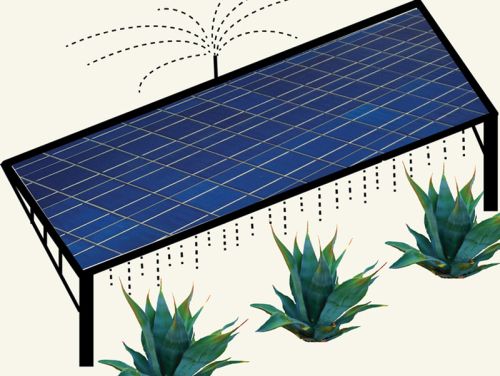“Agrivoltaics” is relatively a new concept that involves cultivating plants like agave in the spaces between and beneath the photovoltaic panels which allow solar plants to use sunlight for electricity generation and also providing crops for biofuels. It offers optimal solutions for problems that are associated with large solar plants. The solar plants located in the arid regions require constant cleaning of its panels from dust, sand particles or bird droppings. The process of cleaning requires water, which apart from cleaning the panels, dampen the soil to suppress the dust particle. On the other side, biofuel generation has limitations as life cycle greenhouse gas emission and engaging land again.
Therefore, researchers from Stanford have brought a new concept of bringing together, solar power plants with agave crops that are used for manufacturing ethanol. This concept is a win win situation for both the solar plant, as well as for the agave plants. Instead of using the land for generating just the power, or cultivating just a single crop over the entire land, the co-location concept could fully utilize the land, says Sujith Ravi, a postdoctoral researcher working along with Professor David Lobell and Chris Field, in environmental Earth system at the Stanford University.
Ravi explains that the water needed for cleaning of solar panels could be also used for agriculture, making the desert more hospitable. The researchers selected plants like agave, which can withstand high temperature, poor soil quality and require a mere amount of water for survival. Agave plants are used to generate biofuel like liquid ethanol that can be mixed with gasoline or used ethanol powered vehicles. Moreover, most of the agave plant can be easily converted to ethanol, unlike corn or other grains.
They observed that the combination of photovoltaic panels and agave cultivation in a given area could produce more output for the amount of water than a solar plant or agave could produce alone. The result showed that only 0.42 liters of water can generate one mega joule of energy.
In the arid areas where these solar plants are located, water availability is limited. So, efficiently managing the water is an essential and employing concept like agrivoltaics seems promising. The same amount of water after cleaning the solar panels would nourish the plants, which in turn also suppress dust as the plants’ roots would anchor the soil and their foliage would help minimize the ability of wind to blow up dust.
The researchers are also trying other innovative ideas to combine photovoltaics with plants rather than just planting crops in between or beneath the panels. According to a report, the National Renewable Energy Laboratory has recommended farmers to make use of unused areas like corners of their land by placing solar panels. The unused corners of the farm plots in Colorado alone, has the potential to produce electricity to meet the entire electricity need of the state. This clearly shows that the combination has a huge potential and a long way to go.
Source: Stanford News




